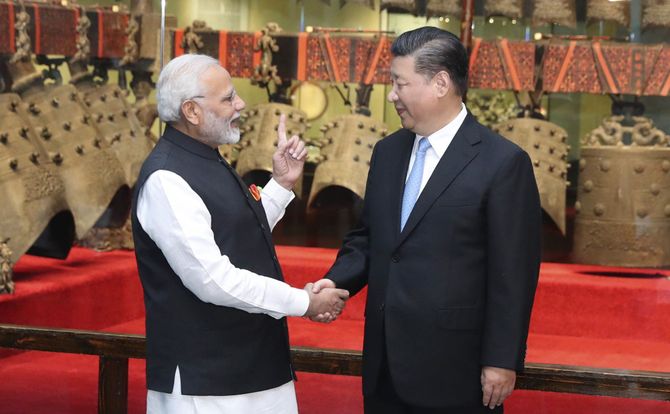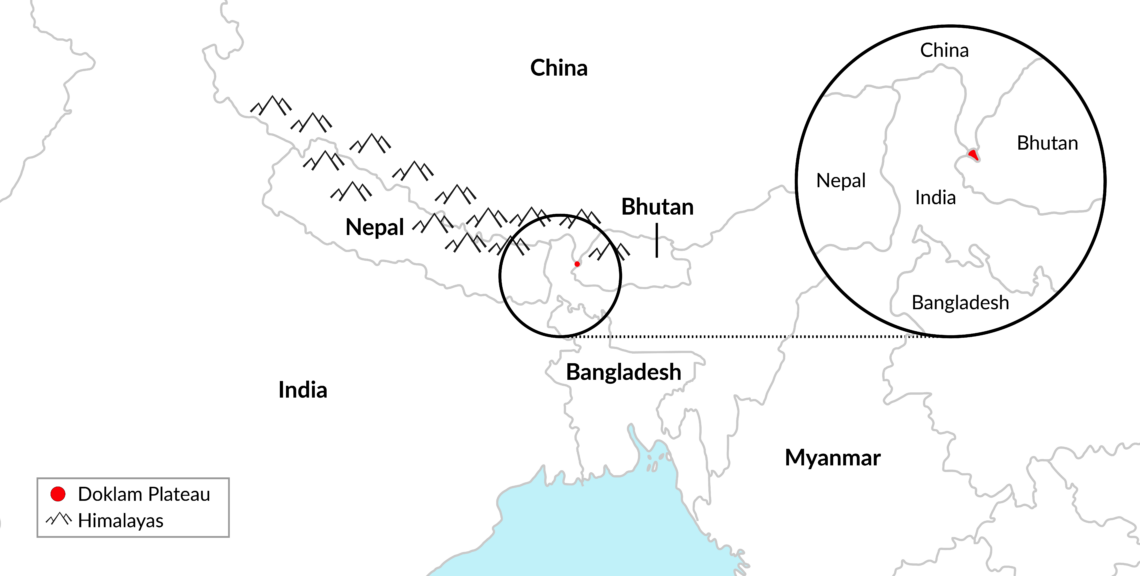Sino-Indian relations after the Wuhan summit
In late April, President Xi Jinping and Prime Minister of India Narendra Modi held an “informal summit” during which they reached a tacit understanding to turn down the heat on their countries’ relationship. But without any concrete steps taken to solve the Asian giants’ big disagreements, renewed confrontation is only a matter of time.

After a remarkably contentious year, India and China have agreed to what can be described as a geopolitical truce. Chinese President Xi Jinping and Indian Prime Minister Narendra Modi held an “informal” summit, to use the official description, in Wuhan, China in late April. The two leaders were together for more than nine hours, had an agenda that lacked any concrete objectives and issued no joint statement. However, the meeting did inspire a lowering of the relationship’s temperature.
The Wuhan summit came after a year of confrontation between India and China over the Dalai Lama’s succession plans, President Xi’s Belt and Road Initiative (BRI) infrastructure project and a 72-day military standoff over a disputed plateau on the Sino-Bhutanese border. Both sides pulled their troops back from the Doklam Plateau at the end of August last year. Several days later, when Prime Minister Modi and President Xi met at a multilateral summit in China, “they agreed neither one wanted a repeat of 2017,” a senior Indian diplomat said.
Over the next few months, officials on both sides met repeatedly. The deeper sources of tension between the two, whether the disputed border or India’s opposition to the BRI, were accepted as being beyond resolution. The two leaders also agreed they had other more pressing concerns, at home and abroad, and would welcome quiet in the relationship. Among other things, diplomats said, it was agreed that Mr. Modi and Mr. Xi would talk about the “state of the world” and explore whether there were more points of convergence in their relations.
Unwritten understandings
The two governments issued separate statements after the Wuhan summit. The statements were innocuous but agreed on the need for “peace and tranquility” along their border and the need for greater “strategic communication.” Officials on both sides stressed both before and after the meeting that no concrete results were expected.
The Indian foreign policy and security establishment sees the meeting as an expedient tactical understanding.
However, it has since become evident that the Wuhan summit did bring about some unwritten understandings. India placed a discreet muzzle on Tibetan nationalist activities on its soil – as it has done in the past when relations with China are warming. Beijing, for its part, seems to have stopped pushing India to endorse the BRI. There was also an agreement to revise the protocols governing military engagement on the border, the fifth such review since 1993. Such reviews are a continuous process reflecting ever-changing military deployments along the Himalayan border.
There were a few surprises. The most striking was an agreement to carry out a joint economic project in Afghanistan. This is likely to be an unambitious solar power plant, say officials, and is probably motivated by Beijing’s desire to send a message it is unhappy with its ally Pakistan’s covert attempts to destabilize the regime in Kabul.
The Indian foreign policy and security establishment, across the board, sees the meeting as an expedient tactical understanding between the two governments. India announced it was increasing its paramilitary deployments along the Chinese border just after the summit. Its officials have also decried the media’s description of the summit as part of a “reset” of India’s China policy. They insist nothing has changed.
Facts & figures
Tension on the Doklam Plateau

Prime Minister Modi must face general elections before April next year, meaning India will be in full campaign mode by autumn. China is the Indian leader’s most difficult foreign policy issue and having it off the table would make his life much easier.
Indian military and intelligence assessments after the Doklam standoff had warned of Chinese retaliation, including a possibly much larger and more protracted border confrontation sometime in 2018. One of New Delhi’s gambles has been to keep a lid on India’s defense spending the past four years to help maintain fiscal discipline. The “spirit of Wuhan” will come as a relief for many in the prime minister’s team who would prefer to divert time and funds to voter-oriented programs.
Xi’s motivations
What is less clear is why President Xi is so eager for a period of quiet with his southern neighbor. Based on their conversations with their Chinese counterparts, Indian diplomats believe Beijing has concluded that it has too many external problems. At the top of the list is a potentially catastrophic trade conflict with the United States, an unpredictable state of affairs regarding North Korea and a spiraling conflict in Afghanistan that could spill over into China’s restive western provinces.
Against this backdrop, China’s problems with India were seen as minor, and Prime Minister Modi himself was perceived as a leader with whom President Xi could do business. Chinese officials also admitted they had been surprised at how successful India’s campaign against the BRI, initially dismissed by Beijing as a quixotic quest, had been in picking up global support.
New Delhi has mild hopes to get some trade concessions from Beijing.
President Xi’s pressing need to carry out structural reforms in the Chinese economy strengthened Beijing’s desire for quiet on its periphery. Even before the Doklam crisis, India’s foreign ministry believed there was evidence Mr. Xi had a more “live and let live” attitude toward India than his own establishment and that his overtures to Mr. Modi just after the latter’s 2014 election were genuine. It was possible that President Xi’s efforts had been stymied because of entrenched biases in the bureaucracies of both sides. Trying to strike a direct, personal relationship with the Indian prime minister was, therefore, a priority for President Xi.
Besides reducing tensions with China generally, New Delhi has mild hopes to leverage the Wuhan opportunity and get some trade concessions from Beijing. In particular, India wants an end to nontariff trade barriers for its pharmaceuticals and software services. India runs a $50 billion trade deficit with China. Beijing did announce a handful of tariff cuts for drugs, but has ignored requests to change its cumbersome drug licensing system.
However, the Indian government has minimal expectations on this issue. The only area of agreement has been a joining of hands at the World Trade Organization to attack the U.S. government’s threatened tariffs on steel and other goods, which target both countries.
Scenarios
India and China are likely to be on their best behavior with each other until the middle of next year. This is the most likely fallout of the Wuhan summit. Each side will avoid provoking the other. More importantly, there will be less military posturing along the border. But the sense of rivalry between the two countries will not diminish. China will continue to expand its economic and military footprint in the Indian Ocean. New Delhi will continue to sign up other governments to oppose the BRI. At some point, an incident will erupt – for example, a political crisis in the Maldives where India is seeking to squeeze out a pro-Chinese leader – in which it will be impossible for India and China to hide their differences, leading to another round of confrontations.
A second scenario has the spirit of Wuhan dissipating within months. As mentioned, many in India believe President Xi is softening largely because of his concerns about a bellicose U.S. A sudden warming of U.S.-China relations could lead Beijing to begin kicking India in the geopolitical shins again. Some of the more skeptical analysts, noting how little India and China have done to address their underlying tensions, argue this could happen as early as this summer.
A third possibility harks back to the sense that President Xi wants a fundamental change in bilateral relations. This school argues that Mr. Xi has struggled to implement his call that “an Asian century” was possible if India and China worked together. Today, having consolidated power in Beijing, things could be different. If Prime Minister Modi comes to believe President Xi’s overtures are genuine, a new sort of relationship could emerge between the world’s two most populated countries.
Friendship is unlikely, but there could be a situation in which the cooperative elements of the relationship come to dominate the competitive ones. This would open the door to a flood of Chinese investment into India, currently a mere $2 billion thanks to barriers put up by New Delhi. It could also see the Indian government invest less in the U.S. strategic relationship.
However, the longevity of such a relationship would depend on Prime Minister Modi and President Xi getting down to some serious diplomacy, whether burying the hatchet over the border or reaching a modus vivendi on the Indian Ocean or Afghanistan-Pakistan. At present, that seems to be the least likely result of the “spirit of Wuhan.”








